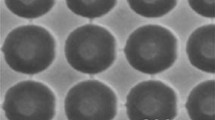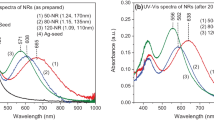Abstract
Formaldehyde is a strong-smelling, colorless, excitant gas that is carcinogenic to humans. It is frequently used in the interior of decorative materials such as wood paneling and carpets. Several epidemiological studies have shown that the increasing incidence of nasal and lung cancer is due to exposure to environmental formaldehyde. Thus, the rapid detection of formaldehyde with high sensitivity is vitally important for environmental monitoring and clinical diagnosis. Surface-enhanced Raman scattering (SERS) is an analytical technique that can provide fingerprint information on target materials with a sensitivity even down to the single-molecule level. However, formaldehyde molecules have a low cross section for Raman scattering and extremely weak analyte–metal interactions, and are thus scarcely detectable with conventional SERS technology. In this paper, a porous zeolitic imidazolate framework-8 (ZIF-8) shell layer was grown in situ on gold nanostars (AuNSs) for capturing and altering the route taken by formaldehyde molecules. Compared with current SERS detection methods, these as-synthesized core–shell AuNS@ZIF-8 nanocomposites with special apertures can cause formaldehyde molecules to pass through the ZIF-8 channels to the metal surface. With the help of ZIF-8 shell layers, the SERS-active AuNS@ZIF-8 substrates display extremely high sensitivity to formaldehyde molecules, with the lowest detection level almost at parts per billion (ppb). This study may therefore provide the basis for a reliable SERS strategy for detecting small molecules, especially gas samples.




Similar content being viewed by others
References
Moskovits M (1985) Surface-enhanced spectroscopy. Rev Mod Phys 57:783–826. https://doi.org/10.1103/RevModPhys.57.783
Xie W, Schlücker S (2014) Rationally designed multifunctional plasmonic nanostructures for surface-enhanced Raman spectroscopy: a review. Rep Prog Phys 77:116502–116524. https://doi.org/10.1088/0034-4885/77/11/116502
Li JF, Huang YF, Ding Y et al (2010) Shell-isolated nanoparticle-enhanced Raman spectroscopy. Nature 464:392–395. https://doi.org/10.1038/nature08907
Alessandri I, Lombardi J (2016) Enhanced Raman scattering with dielectrics. Chem Rev 116:14921–14981. https://doi.org/10.1021/acs.chemrev.6b00365
Willets KA, Van Duyne RP (2007) Localized surface plasmon resonance spectroscopy and sensing. Rev Phys Chem 58:267–297. https://doi.org/10.1146/annurev.physchem.58.032806.104607
Trefry JC, Monahan JL, Weaver KM et al (2010) Size selection and concentration of silver nanoparticles by tangential flow ultrafiltration for SERS-based biosensors. J Am Chem Soc 132:10970–10972. https://doi.org/10.1021/ja103809c
Meng J, Qin S, Zhang L, Yang L (2016) Designing of a novel gold nanodumbbells SERS substrate for detection of prohibited colorants in drinks. Appl Surf Sci 366:181–186. https://doi.org/10.1016/j.apsusc.2016.01.078
Alvarez-puebla RA, dos Santos DS Jr, Aroca RF (2008) SERS detection of environmental pollutants in humic acid-gold nanoparticle composite materials. Analyst 132:1210–1214. https://doi.org/10.1039/b711361g
Li JF, Ding SY, Yang ZL et al (2011) Extraordinary enhancement of Raman scattering from pyridine on single crystal Au and Pt electrodes by shell-isolated Au nanoparticles. J Am Chem Soc 133:15922–15925. https://doi.org/10.1021/ja2074533
Li CY, Dong JC, Jin X et al (2015) In situ monitoring of electrooxidation processes at gold single crystal surfaces using shell-isolated nanoparticle-enhanced Raman spectroscopy. J Am Chem Soc 137:7648–7651. https://doi.org/10.1021/jacs.5b04670
Yang JL, Xu J, He R et al (2017) In situ SERS study of surface plasmon resonance enhanced photocatalytic reactions using bifunctional Au@CdS core-shell nanocomposites. Nanoscale 9:6254–6258. https://doi.org/10.1039/c7nr00655a
Mubeen S, Lee J, Singh N et al (2013) An autonomous photosynthetic device in which all charge carriers derive from surface plasmons. Nat Nanotechnol 8:247–251. https://doi.org/10.1038/nnano.2013.18
Nie S, Emory SR (1997) Probing single molecules and single nanoparticles by surface enhanced Raman scattering. Science 275:1102–1106. https://doi.org/10.1126/science.275.5303.1102
Kneipp K, Wang Y, Kneipp H et al (1997) Single molecule detection using surface-enhanced Raman scattering (SERS). Phys Rev Lett 78:1667–1670. https://doi.org/10.1103/PhysRevLett.78.1667
Pamela MB (2017) Review of SERS substrates for chemical sensing. Nanomaterials 7:1–30. https://doi.org/10.3390/nano7060142
Blackie EJ, Le Ru EC, Etchegoin PG (2009) Single-molecule surface-enhanced Raman spectroscopy of nonresonant molecules. J Am Chem Soc 131:14466–14472. https://doi.org/10.1021/ja905319w
Jeanmaire DL, Duyne RPV (1997) Surface Raman spectroelectrochemistry: part I. heterocyclic, aromatic, and aliphatic amines adsorbed on the anodized silver electrode. J Electroanal Chem 84:1–20. https://doi.org/10.1016/S0022-0728(77)80224-6
Kleinman SL, Ringe E, Valley N et al (2011) Single-molecule surface-enhanced Raman spectroscopy of crystal violet isotopologues: theory and experiment. J Am Chem Soc 133:4115–4122. https://doi.org/10.1021/ja110964d
Kodiyath R, Malak ST, Combs ZA et al (2013) Assemblies of silver nanocubes for highly sensitive SERS chemical vapor detection. J Mater Chem A 1:2777–2788. https://doi.org/10.1039/C2TA00867J
Li RP, Yang GH, Yang JL et al (2016) Determination of melamine in milk using surface plasma effect of aggregated Au@SiO2 nanoparticles by SERS technique. Food Control 68:14–19. https://doi.org/10.1016/j.foodcont.2016.03.009
Fang X, Ahmad SR (2009) Detection of explosive vapour using surface-enhanced Raman spectroscopy. Appl Phys B: Lasers Opt 97:723–726. https://doi.org/10.1007/s00340-009-3644-3
Yu JM, Balbuena PB (2013) Water effects on postcombustion CO2 capture in Mg-MOF-74. J Phys Chem C 117:3383–3388. https://doi.org/10.1021/jp311118x
Sun L, Yu ZL, Lin MS (2019) Synthesis of polyhedral gold nanostars as surface-enhanced Raman spectroscopy substrates for measurement of thiram in peach juice. Analyst 144:4820–4825. https://doi.org/10.1039/C9AN00687G
Du JJ, Jing CY (2011) Preparation of thiol modified Fe3O4@Ag magnetic SERS probe for PAHs detection and identification. J Phys Chem C 115:17829–17835. https://doi.org/10.1021/jp203181c
Noguchi T, Fujishima A, Hashimoto K, Sawunyama P (1998) Photocatalytic degradation of gaseous formaldehyde using TiO2 film. Environ Sci Technol 32:3831–3933. https://doi.org/10.1021/es980299+
Barash O, Peled N, Hirsch FR, Haick H (2009) Sniffing the unique “odor print” of non-small-cell lung cancer with gold nanoparticles. Small 5:2618–2624. https://doi.org/10.1002/smll.200900937
Fuchs P, Loeseken C, Schubert JK, Miekisch W (2010) Breath gas aldehydes as biomarkers of lung cancer. Int J Cancer 126:2663–2670. https://doi.org/10.1002/ijc.24970
Rascon C, Parry AO (2000) Geometry-dominated fluid adsorption on sculpted solid substrates. Nature 407:986–989. https://doi.org/10.1038/35039590
Hao NJ, Yan B (2016) A dual-emitting 4d–4f nanocrystalline metal-organic framework as a self-calibrating luminescent sensor for indoor formaldehyde pollution. Nanoscale 8:12047–12053. https://doi.org/10.1039/c6nr02446g
Zhou HC, Long JR, Yaghi OM (2012) Introduction to metal-organic frameworks. Chem Rev 112:673–674. https://doi.org/10.1021/cr300014x
Ranocchiari M, Bokhoven JAV (2011) Catalysis by metal-organic frameworks: fundamentals and opportunities. Phys Chem Chem Phys 13:6388–6396. https://doi.org/10.1039/c0cp02394a
Chen BL, Xiang SC, Qian GD (2010) Metal-organic frameworks with functional pores for recognition of small molecules. Acc Chem Res 43:1115–1124. https://doi.org/10.1021/ar100023y
Carrillo-Carrión C, Martínez R, Navarro Poupard MF et al (2019) Aqueous stable gold nanostar/ZIF-8 nanocomposites for light-triggered release of active cargo inside living cells. Angew Chem Int Ed Engl 58:7078–7082. https://doi.org/10.1002/ange.201902817
Lin ZJ, Lu J, Hong M, Cao R (2014) Metal-organic frameworks based on flexible ligands (FL-MOFs): structures and applications. Chem Soc Rev 43:5867–5895. https://doi.org/10.1039/c3cs60483g
He L, Liu Y, Liu J et al (2013) Core-shell noble-metal@metal-organic-framework nanoparticles with highly selective sensing property. Angew Chem Int Ed 125:3741–3745. https://doi.org/10.1002/ange.201209903
Men D, Feng SJ, Liu GQ, Hang LF, Zhang T (2020) A sensitive “optical nose” for detection of volatile organic molecules based on Au@MOFs nanoparticle arrays through surface-enhanced Raman scattering. Part Part Syst Charact 37:1900452–1900459. https://doi.org/10.1002/ppsc.201900452
Yang K, Zong SF, Zhang YZ et al (2020) Array-assisted SERS microfluidic chips for highly sensitive and multiplex gas sensing. ACS Appl Mater Interfaces 12:1395–1403. https://doi.org/10.1021/acsami.9b19358
Sui N, Gao HX, Zhu JC, Jiang HR (2019) Shape- and size-dependences of gold nanostructures on electrooxidation of methanol under visible light irradiation. Nanoscale 11:18320–18328. https://doi.org/10.1039/C9NR06839B
Zheng GC, Marchi SD, López-Puente V et al (2016) Encapsulation of single plasmonic nanoparticles within ZIF-8 and SERS analysis of the MOF flexibility. Small 12:3881–3890. https://doi.org/10.1002/smll.201670141
Zhou L, Su P, Deng YL, Yang Y (2017) Self-assembled magnetic nanoparticle supported zeolitic imidazolate framework-8: an efficient adsorbent for the enrichment of triazine herbicides from fruit, vegetables, and water. J Sep Sci 40:909–918. https://doi.org/10.1002/jssc.201601089
Handa S, Gnanadesikan V, Matsunaga S, Shibasaki M (2010) Heterobimetallic transition metal/rare earth metal bifunctional catalysis: a Cu/Sm/Schiff base complex for syn-selective catalytic asymmetric nitro-mannich reaction. J Am Chem Soc 132:4925–4934. https://doi.org/10.1021/ja100514y
Yang JL, Wang HJ, Zhang H, Tian ZQ, Li JF (2020) Probing hot electron behaviors by surface-enhanced Raman spectroscopy. Cell Rep Phys Sci 1:100184. https://doi.org/10.1016/j.xcrp.2020.100184
Nandi S, Sharma E, Trivedi V, Biswas S (2018) Metal-organic framework showing selective and sensitive detection of exogenous and endogenous formaldehyde. Inorg Chem 57:15149–15157. https://doi.org/10.1021/acs.inorgchem.8b02411
Acknowledgements
This work was supported by the National Natural Science Foundation of China (61805069 and U1904193), the Science and Technology Development Project of Henan Province (182102210029).
Author information
Authors and Affiliations
Corresponding authors
Ethics declarations
Conflict of interest
The authors declare no conflicts of interest.
Additional information
Handling Editor: Pedro Camargo.
Publisher's Note
Springer Nature remains neutral with regard to jurisdictional claims in published maps and institutional affiliations.
Electronic supplementary material
Below is the link to the electronic supplementary material.
Rights and permissions
About this article
Cite this article
Fu, Y., Xin, M., Chong, J. et al. Plasmonic gold nanostars@ZIF-8 nanocomposite for the ultrasensitive detection of gaseous formaldehyde. J Mater Sci 56, 4151–4160 (2021). https://doi.org/10.1007/s10853-020-05507-4
Received:
Accepted:
Published:
Issue Date:
DOI: https://doi.org/10.1007/s10853-020-05507-4




